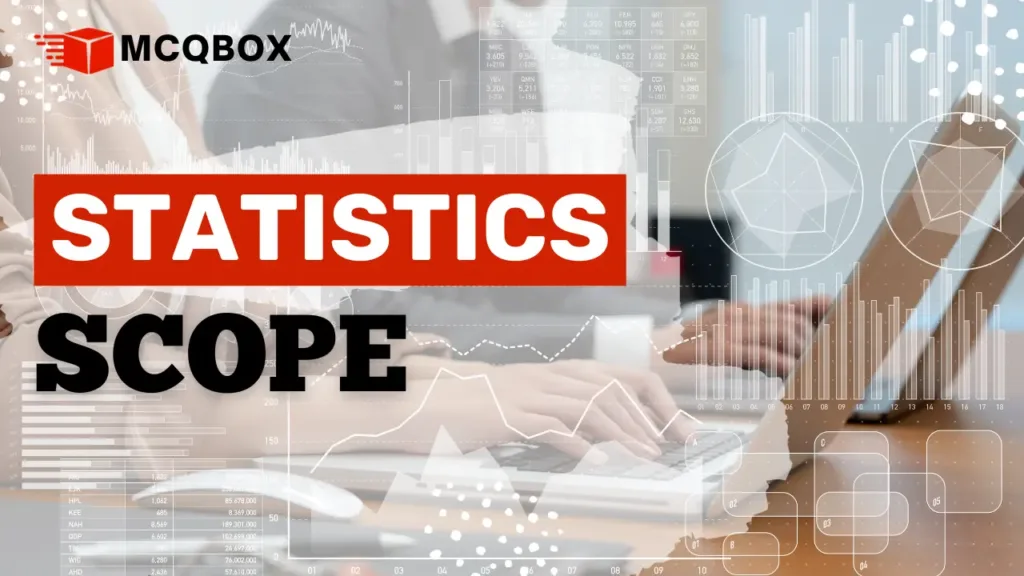Table of Contents
Scope of Statistics

I. Introduction Scope and Importance of statistics
Statistics is not just a subject taught in classrooms; it is a powerful tool that fills every aspect of our lives. From analyzing economic trends to predicting the outcome of sports events, statistics play a crucial role. In this article, we will explore the definition of statistics, its types, applications in various fields, challenges, future trends, and the importance of statistical literacy.
A. Definition of Statistics
Statistics is the science of
- Collecting
- Analyzing
- Interpreting
- Presenting
- Organizing data.
It involves the use of mathematical principles to draw meaningful insights from raw information.
B. Importance of Statistics in Various Fields
Statistics is the backbone of decision-making in various fields such as business, healthcare, education, and more. It enables professionals to make informed choices based on evidence rather than intuition. Whether it’s predicting market trends or understanding public health patterns, statistics empower us with valuable insights.
II. Types of Statistics

There are two branches of Statistics
A. Descriptive Statistics
1. Measures of Central Tendency
Mean: The average value of a set of data points, calculated by summing all values and dividing by the number of observations.
Median: The middle value of a dataset when arranged in ascending order.
Mode: The value that occurs most frequently is mode in a dataset.
2. Measures of Dispersion
Range: The difference between the maximum and minimum values in a dataset.
Variance: A measure of the spread of data points from the mean.
Standard Deviation: A statistical measure of the amount of variation within a set of values.
B. Inferential Statistics
Probability Distributions
Inferential statistics uses probability distributions to make predictions about a population based on a sample. Understanding these distributions is crucial for drawing accurate conclusions from the data.
Hypothesis Testing
Null Hypothesis: The default assumption is that there is no significant difference or effect.
Alternative Hypothesis: The statement that contradicts the null hypothesis, suggesting a significant difference.
Significance Level: The threshold at which the null hypothesis is either accepted or rejected.
III. Applications of Statistics
A. Business and Economics
In the business world, statistics aids in
- Market research
- Risk analysis
- Financial forecasting.
It helps organizations make strategic decisions by providing insights into consumer behavior and market trends.
B. Healthcare
- Medical Research
- Clinical Trials
- Epidemiology
C. Social Sciences
In sociology, psychology, and political science, statistics helps researchers analyze human behavior, societal trends, and political preferences. It provides a quantitative framework for understanding complex social phenomena.
D. Sports Analytics
From player performance evaluation to predicting game outcomes, sports teams leverage statistics for a competitive edge. Moneyball, the famous application of statistics in baseball, is a testament to its impact on sports analytics.
IV. Challenges in Statistics
Data Quality
One of the primary challenges in statistics is ensuring the quality of the data collected. Inaccurate or biased data can lead to faulty conclusions and unreliable predictions.
Sampling Errors
Drawing conclusions about an entire population based on a sample introduces the risk of sampling errors. The representativeness of the sample is crucial for the generalization of results.
Misinterpretation of Results
Even with accurate data, misinterpretation of statistical results is common. It is essential to communicate findings clearly and avoid drawing unwarranted conclusions.
V. Future Trends in Statistics
Big Data Analytics
The advent of big data has revolutionized the field of statistics. Analyzing massive datasets allows for more accurate predictions and a deeper understanding of complex phenomena.
Machine Learning and Artificial Intelligence
Statistics form the foundation of machine learning algorithms and artificial intelligence. These technologies rely on statistical models to learn from the data and make predictions.
VI. Career in Statistics
| Level | Course |
|---|---|
| Certificate & Diploma courses | Certificate in Statistical Methods and Applications |
| Diploma Courses in Statistics | |
| Bachelor Courses | Bachelor of Arts (BA) in Statistics |
| Bachelor in Statistics | |
| Bachelor of Science (Hons) in Statistics | |
| Master Courses | Master of Arts in Statistics |
| Master in Statistics | |
| Master of Science (Hons) in Statistics | |
| M.Phil | Master of Philosophy in Statistics |
| Doctoral Courses | PhD in Statistics |